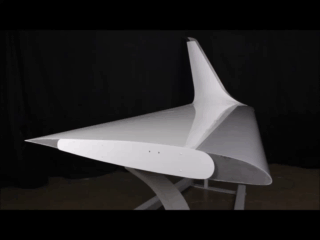Improving Aerodynamics
Successfully flight tested by the Air Force and NASA on a Glufstream III aircraft, FlexSys has developed this variable geometry trailing edge structure for fixed-wing aircraft. With projected fuel savings from 2-11%, a joint venture was formed with Aviation Partners and commercial deployment is expected in 2020.
The Air Force purchased this Gulfstream GIII and gave it to NASA to test FlexFoil™, Learn why.
Fixed Wing Aircraft
FlexFoil™ variable geometry control surfaces represent a major improvement over conventional aircraft flaps. By exploiting the natural elasticity of aviation grade materials, the FlexFoil™ control surface changes the camber of a wing during flight by shape morphing rather than through the heavy and cumbersome mechanisms of conventional wing flap assemblies. Shape morphing performs the large controlled deformations (from -9° to + 40°) needed for landing and takeoff using a surface that is integral to the rest of the wing. FlexFoil also permits discrete span-wise twist of the compliant edge at high response rates (up to 30 degrees/sec.) to reduce induced drag and withstand external loads (air loads, inertial loads etc.), yet it is strong and stiff with very small distributed strains on the mechanical structures and control surfaces.
Rotorcraft
FlexSys variable geometry technology can be applied to both the trailing edge and leading edge control surfaces for rotorcraft to improve flow characteristics at high rates.
1 cycle/rev large deflection for cyclic control
5 cycles/rev for vibration control.
10% chord has equivalent aero performance as a 15% railing edge conventional flap
Consumes 20% less power than a conventional flap.
The leading edge structure is made of Titanium and is capable of 10° LE droop once per rev.
The trailing edge utilizes fiberglass for it's structure and is capable of up to 5 cycles per rev.
Active Surface Flow Control Devices
FlexSys proprietary design motion amplifiers can be integrated with piezostack actuators to produce high frequency oscillations in micro vortex generators (VG) for active surface flow control applications. The resulting system is lightweight and consumes very low power for wide range of oscillation frequencies. Wind tunnel tests demonstrated the effectiveness of our FlexSys system in delaying the flow separation and extending the operation lift range.
Piezo-compliant actuators create a static or oscillatory mechanical disturbance in the boundary layer, and can be retracted so they are flush with the control surface when not in use.
FlexSys Adaptive Edge is a seamless, shape morphing, trailing edge for utility scale wind turbines. The FlexSys Adaptive Edge enables turbine blades, for the first time, to respond with the same bandwidth as fluctuations in the incoming wind through continuous sense-and-control.
5 to 9% reduction in the cost of wind energy;
10-15% increases in energy capture in typical utility scale turbines;
Significant stress reduction in the blade and the gearbox, protecting the infrastructure from severe stresses due to wind gusts.
An opportunity to potentially eliminate the need for blade pitch mechanisms.




